Did you know that every year, thousands of house cats face threats from various predators, some of which might be lurking right in your backyard? From the stealthy cougar to the elusive fox, our feline friends often find themselves on the radar of some of nature’s most formidable hunters. But it’s not just the wild creatures we need to watch out for. Even seemingly innocuous encounters, like those with a neighborhood dog, can be dangerous for our whiskered companions!
In this article, we’ll discover the top 11 predators your house cat might encounter. And, of course, we’ll also provide some essential tips to keep them safe and sound.
1. Cougars (Puma concolor)

One of the most dangerous house cat predators out there is the cougar, also called the mountain
lion
or puma.
©eumates/Shutterstock.com
Cougars, also called mountain lions or pumas, have a huge range across the U.S., with sightings stretching all the way south to Patagonia. These big cats are formidable predators, and they look very similar to a domestic cat, only much larger! These predators predominantly target larger wildlife such as deer, elk, and coyotes in their hunts.
However, they’re also opportunistic hunters targeting livestock or smaller animals, including wandering domestic cats. Just like our house cats, cougars adopt a stealthy approach, striking prey unexpectedly, aiming for a fatal bite at the head or neck. They are mostly active from dusk to dawn. Human encounters are rare, yet they can unfold into dangerous situations. If you spot a cougar near your home, it’s crucial to alert animal control or the police right away!
2. Wolves (Canis lupus)

It’s not surprising to hear that another major house cat predator is the wolf, a member of the canine family.
©Mircea Costina/Shutterstock.com
Wolves are grand members of the canine family. Once tottered towards extinction, they were victims of habitat destruction and hunting. However, these wolves play an important and vital role in the local ecosystem in managing prey populations. Due to this reason, conservationists swooped in, leading to the enactment of protective legislation like the U.S. Endangered Species Act. Consequently, wolves witnessed a resurgence.
As humans encroach more onto their natural territories, the interactions between wolves and humans are escalating. That means house cats have been having chance encounters with these predators as well. Being adept predators, wolves might eye cats as potential prey, especially during the harsh winter seasons, when food becomes scarce, or when they are nurturing their young. These animals are opportunistic hunters, seizing any available prey, sometimes including unsuspecting cats.
3. Dogs (Canis lupus familiaris)

One house cat predator you may not have considered is the dog, which can be dangerous if not properly trained.
©Foto Zlatko/iStock via Getty Images
You might be surprised to hear this, but dogs are vicious house cat predators as well. Dogs may be a man’s best friend, but they’re not always friendly with our feline companions. Dogs, with their varied sizes, appearances, and behaviors, can pose a significant threat to cats. While many domestic dogs might simply be curious or playful, their sheer size and strength can inadvertently harm a cat.
On the other hand, feral dogs or dogs without proper training can be more aggressive and view cats as potential prey. It’s not just about the bite; even a chase can lead to injuries or stress for our beloved cats, whether it’s the neighbor’s friendly golden retriever or a stray. For this reason, it’s always best to be cautious and supervise any interactions between dogs and cats.
4. Coyotes (Canis latrans)
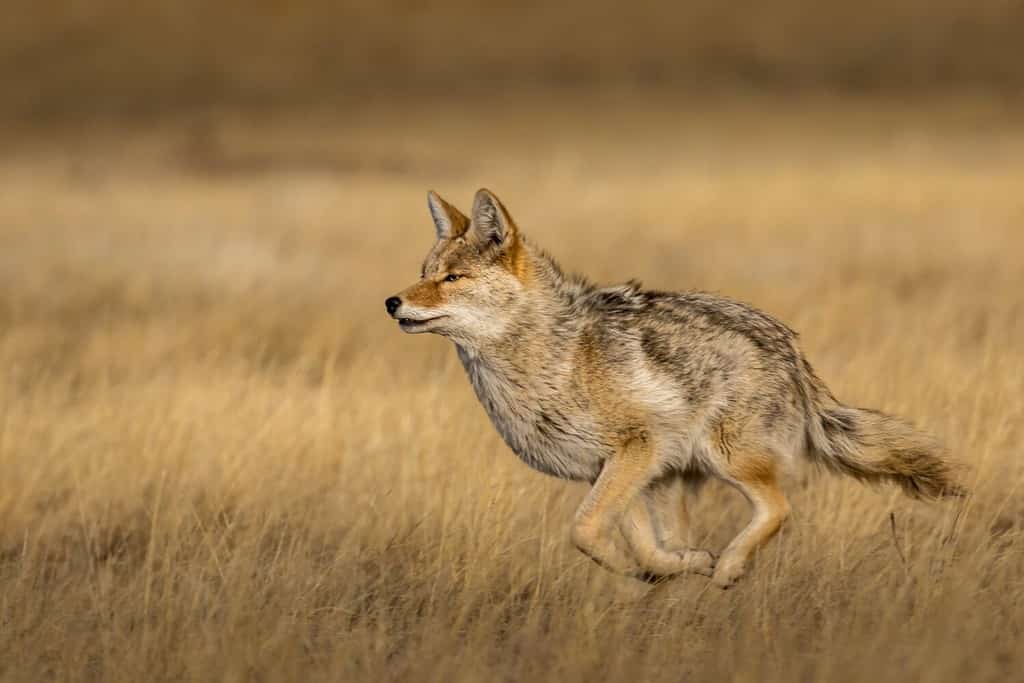
These medium-sized canines are well-known house cat predators.
©Dennis Laughlin/Shutterstock.com
The coyote is a clever and adaptable predator that’s become quite the talk of the town. These creatures, often confused for medium-sized dogs, sport a tawny, grayish-brown coat with a bushy tail. They’ve spread all over the United States, from the hectic outskirts of cities to peaceful rural areas. Sadly, these nocturnal canines have a craving for our feline companions. While you may rarely spot one in the middle of the city, you may find one lurking around a park or the edge of a town. In fact, they are pretty tolerant of human activities.
There’s a huge range when it comes to a coyote’s diet. These opportunistic predators are both hunters and scavengers, generally eating small animals. They’ll eat anything from snowshoe hares, mice, beavers, squirrels, frogs, fish, and even birds. In the summer and fall months, they’ll eat grass, berries, and fruit as well. Unfortunately, pets are also sometimes on the menu — this includes your house cat!
5. Birds of Prey (Eagles, Owls, Hawks)

A variety of birds of prey may hurt, kill, and even eat your house cat, especially if the cat is rather small.
©Travis Morita/iStock via Getty Images
All sorts of birds of prey, including eagles, hawks, and owls, are potential house cat predators. These birds have sharp talons and beaks for seizing and consuming prey. While they pose a threat to all house cats, they are especially dangerous for kittens or smaller breeds. Seeing these tiny creatures, these birds of prey might see them as prey.
These predatory birds swoop down from high altitudes to grasp your feline friend with their talons, causing significant harm or even death. And yes, as gory as it sounds, they’ll eat them, too. Some birds of prey may also chase cats. They do this to protect their territory.
6. Porcupines (Accipitridae)
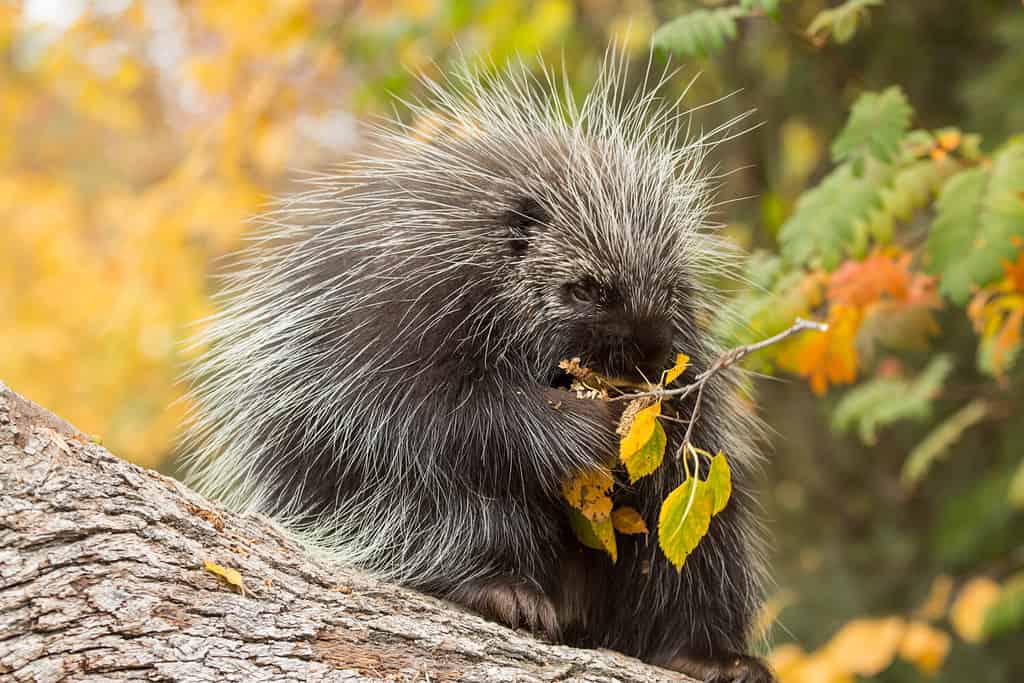
While porcupines may not necessarily eat your cat, they can be dangerous due to their quills!
©Warren Metcalf/Shutterstock.com
Porcupines are nocturnal herbivorous rodents with quills as a defense mechanism. They primarily feed on plant material and sometimes insects or small animals. In interactions with house cats, porcupines pose a threat. This is due to their sharp quills, which will embed in a cat’s skin if they get too close.
The barbed quills are painful and hard to remove, requiring veterinary intervention. While serious injuries are rare, encounters can cause a lot of discomfort.
7. Venomous Snakes (Serpentes)
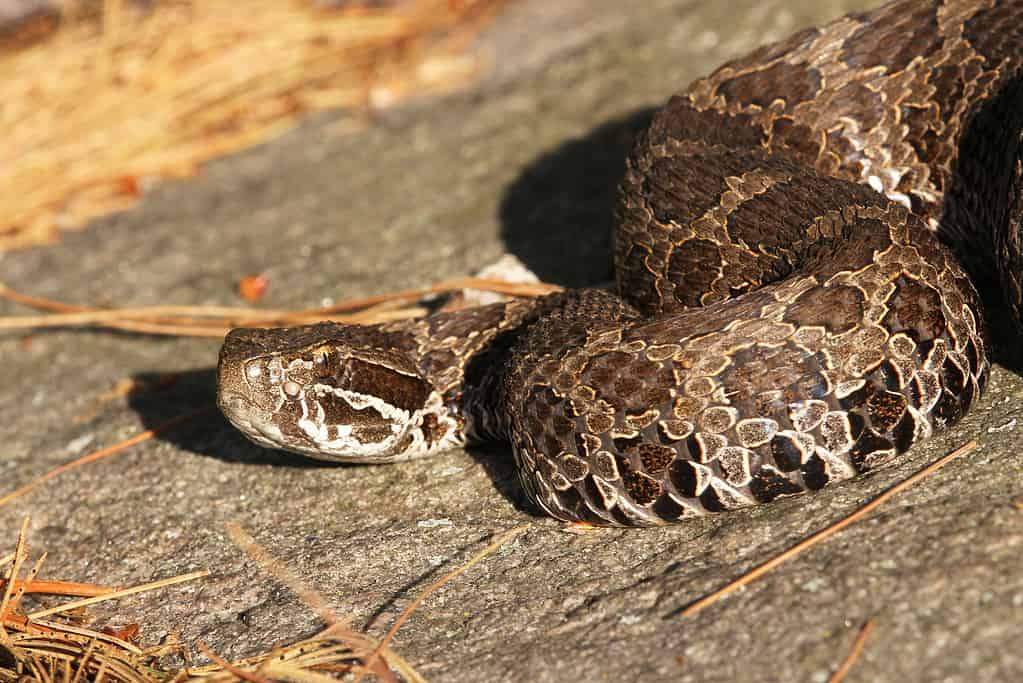
Venomous snakes, such as rattlesnakes (pictured), copperheads, and water moccasins, can be dangerous to house cats.
©khorner/iStock via Getty Images
While not all snakes are venomous, some snakes can produce venom. This venom is used for defense, prey immobilization, and digestion assistance. Venomous snakes come in a variety of sizes, with smooth, legless bodies. These bodies are covered in overlapping scales. Venomous snakes inhabit diverse ecosystems around the world, excluding arctic or sub-arctic regions.
In the United States, you’ll need to watch out for pit vipers like rattlesnakes, copperheads, and water moccasins. For house cats (not to mention for us, too!), encounters with venomous snakes are dangerous. A snake can inject venom into the cat, causing serious illness or death if not treated promptly.
8. Rats (Rattus)

While cats may eat rats, rats can also kill small cats and kittens!
©Nigel Harris/iStock via Getty Images
Another surprising house cat predator is the rat. Rats are medium-sized rodents with a body length of 6 to 11 inches and a long tail. These rodents have large ears, a sleek, fur-covered body, and a long, scaly tail. Highly adaptable, they thrive in various habitats, including human settlements. This includes urban, suburban, and rural areas. Primarily, their diet is vegetarian, but they are considered omnivores. Rats are not picky eaters, consuming anything from grains to garbage.
Interaction with house cats can be risky as rats can deliver a painful bite! But beyond the pain, this bite can potentially transmit diseases or fleas to cats. Although cats may prey on rats, a rat may even be able to kill small cats and kittens.
9. Raccoons (Procyon lotor)
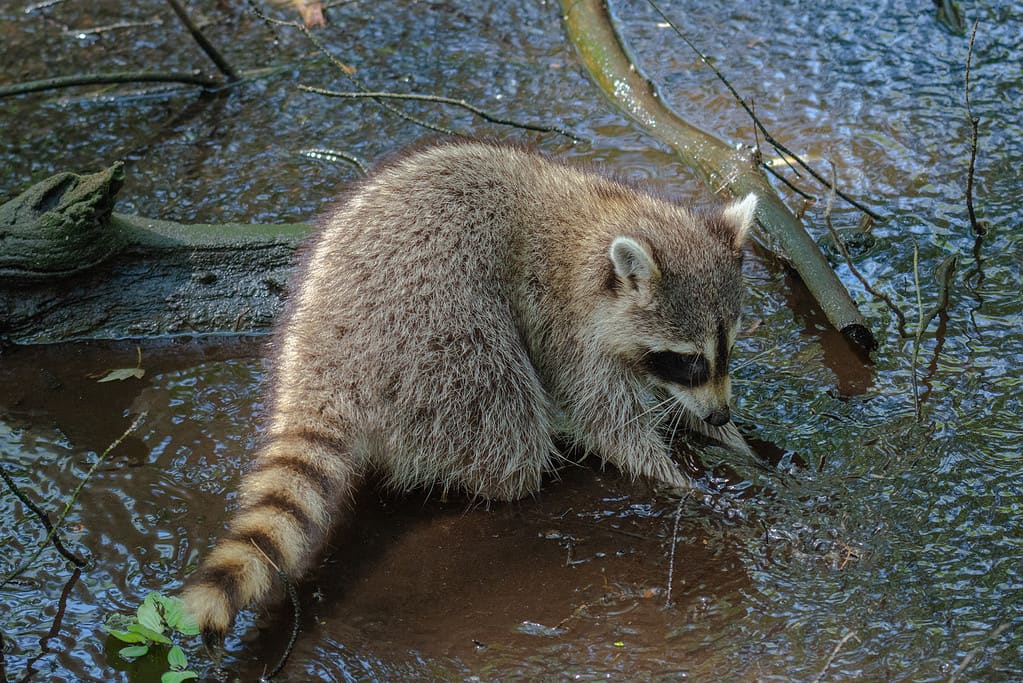
Another noteworthy house cat predator is the raccoon, which may attack and eat your feline companion if hungry enough.
©ad-e-motion/iStock via Getty Images
Raccoons are recognizable by their famous bandit’s mask and ringed tail. These animals measure about 23 to 38 inches and weigh between 10 and 20 pounds. They are native to North America and prefer habitats near water sources like streams. Notably, raccoons adapt well to various environments, including urban areas. These mammals are omnivorous, eating anything from aquatic creatures to garbage.
Interaction with house cats can be dangerous, as raccoons might attack cats, causing harm through bites or scratches. Furthermore, if the raccoon is hungry enough, it may attack and eat your cat! These animals can also transmit diseases like rabies or lethal intestinal disease, such as Baylisacaris procyonis, and parasites.
10. Spiders (Araneae)
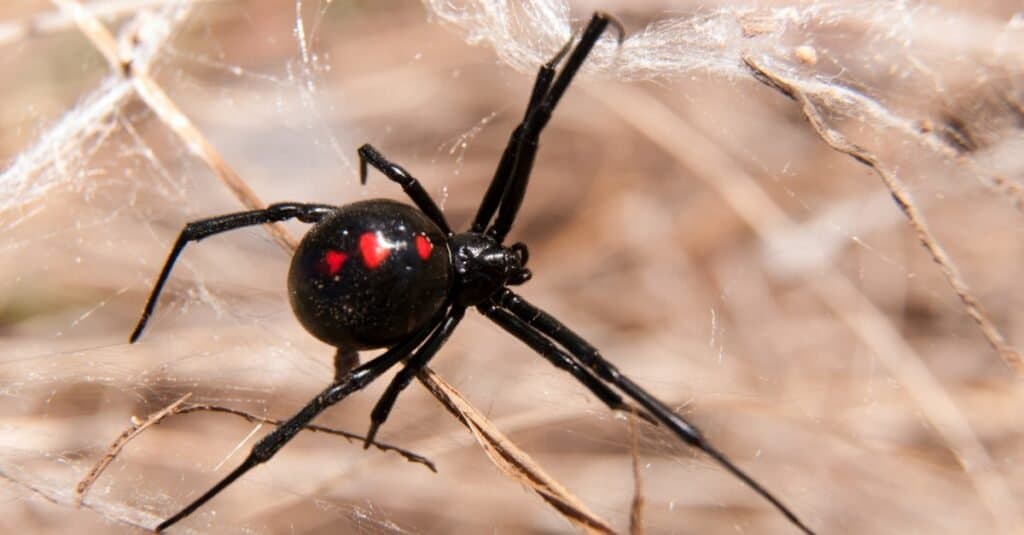
While not all spiders are dangerous, some spiders, like the black widow (pictured), can kill cats with their venom.
©Sari ONeal/Shutterstock.com
Spiders, with their eight legs and fangs capable of injecting venom, primarily feed on insects. While most spider species are harmless to cats, venomous species like black widow and brown recluse spiders can pose huge risks. Black widow spider bites may cause severe reactions in cats, not to mention humans as well. This includes paralysis, muscle spasms, and even death. Brown recluse spider bites can result in skin lesions, though fatalities are less common.
Generally, it’s safe for cats to eat spiders as venom usually gets deactivated during digestion, but sometimes cats can show mild symptoms of gastrointestinal upset after eating a venomous spider. It is best to look out for the signs if your cat has eaten venomous spiders for precautionary measures.
11. Foxes (Vulpes vulpes)
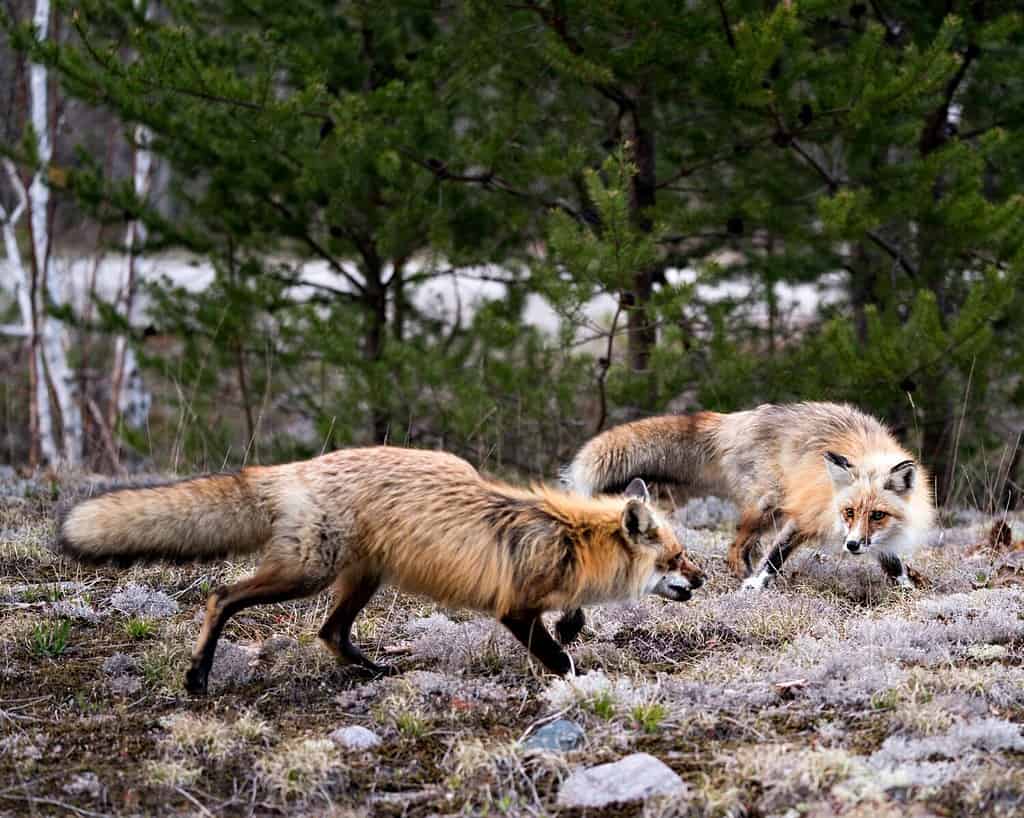
Cats and foxes generally ignore each other, but in some cases, they may attack one another.
©Rejean Aline Bedard/Shutterstock.com
Foxes resemble small to medium-sized bushy-tailed dogs with pointed ears and snouts. These canines come in various sizes. They adapt well, so you may see them in human-dominated areas, and their habitats generally range from Arctic tundra to arid desert. Foxes also thrive in farmlands, woods, cities, and suburbs. While their diet comprises mice, voles, rabbits, eggs, fruit, and birds, occasionally, they feast on carrion, garbage, or unattended pet food.
Foxes and cats usually ignore each other. These predators generally act defensively rather than aggressively. However, in the presence of their offspring, foxes might behave aggressively towards cats. On the flip side, cats can kill juvenile foxes as well, so this danger goes both ways. Fox attacks on cats are rare but can occur, particularly with smaller cats and kittens. Furthermore, in situations where the fox is starving or habituated to human presence, urban red foxes pose a higher threat to cats than rural foxes.
Tips to Keep Your House Cat Safe from Predators
Now, you can see that there’s a wide range of predators out in the open that may hurt and even eat your cat! So, what can you do to keep your feline companion safe? Ensuring your cat’s safety requires vigilance, preparation, and a touch of creativity. Let’s delve into some measures you can adopt.
Supervised Outdoor Time
One of the simplest and most effective ways to ensure your cat’s safety is to supervise their outdoor excursions. If the idea of a cat on a leash and harness seems odd, think again. More and more cat owners are embracing this method. They find that it allows their cats to enjoy the outdoors without the risks. Alternatively, consider creating an enclosed outdoor space or “catio.” Your cat can lounge and play in safety here.
Identification and Tracking
Mishaps can occur, and a curious cat might find a way to venture out, or an unexpected event might separate you. In case this happens, ensure your cat has a collar with an identification tag. This tag should bear your contact details. Additionally, microchipping your cat can provide an added layer of assurance. Should your cat go missing, these identifiers make it significantly easier. Another method is to put an Airtag collar on your cat.
Safe Outdoor Environment
As the age-old adage says, cats are curious by nature and often drawn to explore new territories. If you live near areas with frequent predator sightings, it’s best to steer clear of them. If you have a yard, consider installing a fence. And add cat-proof measures such as overhangs or roller bars. This prevents cats from climbing over or predators from getting in.
Nighttime Safety
Many predators, like coyotes and owls, are most active during dawn, dusk, and nighttime. These times pose the highest risk for your feline friend. By keeping your cat indoors during these hours, you drastically reduce their exposure to potential threats.
Spaying and Neutering
Unspayed or unneutered cats have a natural tendency to wander in search of mates. Spaying or neutering your cat can reduce this wandering instinct. It keeps them closer to home and away from potential dangers.
Should You Keep Your Cat Indoors?
The debate about indoor versus outdoor cats is as old as time (or at least as old as domesticated cats!). Here’s a breakdown.
- Pros of keeping a cat indoors: There’s a clear safety advantage when it comes to shielding your cat from potential predators. Moreover, indoor cats are less exposed to diseases like FIV (Feline Immunodeficiency Virus) and have a reduced risk of accidents such as road mishaps.
- Cons of keeping a cat indoors: Cats have innate hunting and exploring instincts. Keeping them indoors might lead to a lack of stimulation for these natural behaviors, potentially leading to obesity or behavioral issues.
- Recommendations: If you’re torn between the two options, consider a balanced approach. Keep them mostly at home, but allow your cat some supervised outdoor time while being mindful of the area’s risks.
Summary of 11 House Cat Predators
| Number | House Cat Predator | Taxonomy |
|---|---|---|
| 1. | Cougars | Puma concolor |
| 2. | Wolves | Canis lupus |
| 3. | Dogs | Canis lupus familiaris |
| 4. | Coyotes | Canis latrans |
| 5. | Birds of Prey | Eagles: AccipitridaeOwls: StrigiformesHawks: Buteo |
| 6. | Porcupines | Erethizon dorsatum |
| 7. | Venomous Snakes | Serpentes |
| 8. | Rats | Rattus |
| 9. | Raccoons | Procyon lotor |
| 10. | Spiders | Araneae |
| 11. | Foxes | Vulpes vulpes |
The photo featured at the top of this post is © Mircea Costina/Shutterstock.com
Thank you for reading! Have some feedback for us? Contact the AZ Animals editorial team.







